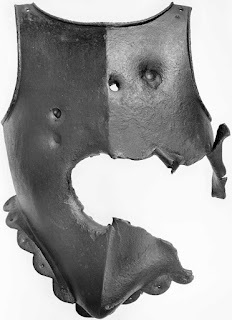Armor as Damage Reduction
 One of the first blogposts of the OSR that I remember being widely celebrated and discussed was "Shields Shall Be Splintered!" by Trollsmyth. If you've somehow never read it before, take a moment to follow the link and do so. The post isn't long and the idea behind it is a simple but clever one.
One of the first blogposts of the OSR that I remember being widely celebrated and discussed was "Shields Shall Be Splintered!" by Trollsmyth. If you've somehow never read it before, take a moment to follow the link and do so. The post isn't long and the idea behind it is a simple but clever one.
I found myself thinking about Trollsmyth's post again recently, as I was re-reading a section of Unearthed Arcana that I rarely see discussed. In the Dungeon Masters' Section of the book, you'll find descriptions of new armor types. Among these are field plate armor and full plate armor, which, in addition to filling out the AD&D armor class table all the way to AC 0, introduce two new mechanics into the game that, so far as I recall, doesn't exist anywhere else: armor as damage reduction and damage to armor.
Here's how those mechanics are described in the description of field plate:
For every die of damage that would be inflicted upon the wearer from any attack, physical or magical, the armor will absorb 1 point of the damage. (On a damage roll of 1, the wearer would take no damage.) For example, the armor will absorb 1 point of damage from the strike of a long sword, and the damage from an ice storm (3–30, or 3d10) would be reduced by 3 points, and the damage from the breath weapon of a 9 HD dragon is reduced by 9 points. However, after the armor absorbs 12 points of damage in this fashion, it is damaged and must be repaired. Until repairs are made, it cannot absorb further damage and is considered one armor class worse in protective power. Damaged field plate may be repaired by a trainer armor [sic] at a rate of 100 gp per point of absorbing power restored, and one day of time per point restored.
Full plate armor functions more or less identically, though its absorption is 2 points per die of damage and it has a total absorption capacity of 26 points before it needs repair.
A couple of thoughts occurred to me as I re-read this section. Firstly, I had apparently forgotten the rules associated with these new armor types. I suspect that's because, like so many things that later appeared in Unearthed Arcana, I remember more strongly the original appearance of field and full plate in Gygax's "From the Sorcerer's Scroll" column in issue #72 of Dragon. Unless my recollection is gravely in error, those new types of armor did not provide any reduction to the damage inflicted on their wearers. Instead, they were simply better types of plate with accordingly better AC ratings. Damage reduction/absorption is thus something new to UA (though, as always, I am happy to be corrected on this point).
Secondly, I had long understood the rating of a type of armor in AD&D (and D&D, for that matter) to represent how difficult it was to damage its wearer. Characters with lower AC ratings were not "harder to hit," but harder to damage. I know that D&D often speaks of a "to hit" roll, but I take that to be shorthand for "to hit in a way that results in damage." If so, does an additional layer of damage absorption make any sense? Does this addition to the way hits and damage work in AD&D do violence to the combat rules or only to my peculiar interpretation of what hit and damage rolls represent in AD&D?
Armor as damage reduction isn't a new idea. Many RPGs that followed in D&D's wake – RuneQuest being one of the best examples – view armor in this fashion. However, those games broadly divorce the difficulty of striking an opponent in combat from the armor that they wear. D&D has always been a bit more vague on this subject, partly in the interests of efficiency. Whatever else you might say about D&D combat, it's fast. D&D has always sacrificed "realism" for speed of play, which I think is the right call in most cases. That's why I find the damage absorption rules for field and full plate rather odd. To my mind, they don't fit with the overall philosophy of D&D combat.
Of course, re-reading this section of Unearthed Arcana also made me wonder if Gygax's thinking had changed on the matter of armor and/or combat. If so, what might we have seen in his version of Second Edition? Might we have seen a broader implementation of damage reduction in the game? It's a question with no definitive answer, but it's fun to ponder nonetheless.
James Maliszewski's Blog
- James Maliszewski's profile
- 3 followers



